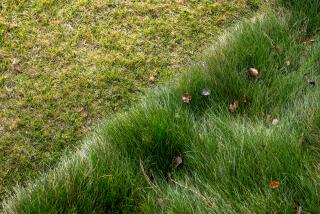Combating the Factors That Threaten Lawn Order
- Share via
A healthy lawn needs three things: sunlight, water and nourishment.
Sunlight--several hours a day--is important. Grass seeds are available for shady areas, but even that type of grass needs sunlight.
A healthy lawn also needs water. An inexpensive rain gauge can tell you how much water your lawn is getting. Or use a spade to open a slit 6 to 8 inches deep; the soil should be damp at the bottom.
A simple test: If your footprints stay on the lawn, it needs water. Well-watered turf springs back; dry grass doesn’t.
Grass normally goes dormant and turns brown in the hot, dry days of summer, then revives with the next good rainfall.
To keep your lawn green in dry spells, give it a thorough weekly soaking, preferably during the morning. Frequent light waterings make roots shallow and encourage weeds.
Most grasses do best in neutral to slightly acid soil (pH 7 to 6). With a kit from a garden center, test the soil from several places in your lawn. If the pH is lower than 6, add ground limestone in late fall.
Do not apply fertilizer within two weeks of applying lime and wait at least three years before applying lime again. If you’ve already limed too much, and your soil is too alkaline (higher than pH 7), spread gypsum, powdered sulfur, peat moss or well-rotted manure.
The best defense against weeds, disease and insects is a well-nourished, properly tended lawn. When weeds do appear, pull them before they go to seed, using a long weeder to get all the roots.
Herbicides are available for both crab grass and for such broad-leaved weeds as dandelions, hawkweed and plantain.
*
When using herbicides, follow the manufacturer’s directions carefully. Small doses applied directly to the weeds are better than large-scale applications, which may injure or kill many desirable plants.
If your lawn gets heavy foot traffic, loosen the soil once a year with a garden fork; push the fork into the soil every few inches and wiggle it back and forth. Or wear strapped-on “spiker shoes,” available at garden centers, to aerate soil while mowing. For a large lawn, use a mechanical aerator.
When buying grass seed, it’s worth paying a higher price for brands with the lowest percentage of weeds. Check the labels.
Here are some tips:
* Moss indicates the lawn needs better drainage, more frequent fertilization and lime.
* Moles indicate grubs. Treat the lawn with insecticide to rid it of grubs, and the moles will depart.
* Patches of turf mysteriously torn up overnight? Quite likely the work of insect-seeking raccoons or skunks. A sprinkling of moth crystals may help to persuade them to dine elsewhere.






